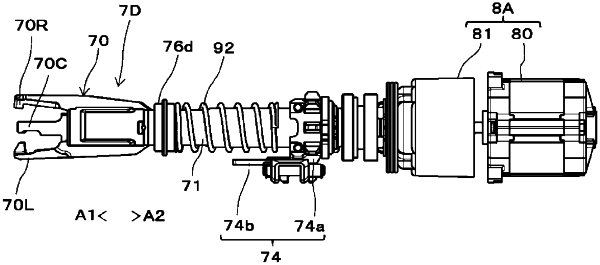| CPC B65B 13/025 (2013.01) [B25B 25/00 (2013.01); B65B 13/22 (2013.01); B65B 13/285 (2013.01); E04G 21/123 (2013.01)] | 4 Claims |

|
1. A binding machine comprising:
a wire feeding unit configured to feed a wire;
a curl forming unit configured to form a path along which the wire fed by the wire feeding unit is to be wound around a to-be-bound object;
a butting part against which the to-be-bound object is to be butted;
a cutting unit configured to cut the wire wound on the to-be-bound object; and
a binding unit configured to twist the wire wound on the to-be-bound object,
wherein the binding unit comprises:
a rotary shaft;
a wire engaging body configured to move in an axis direction of the rotary shaft and to engage the wire in a first operation area in the axis direction of the rotary shaft, and configured to move in the axis direction of the rotary shaft and to twist the wire when rotating together with the rotary shaft in a second operation area in the axis direction of the rotary shaft;
a rotation regulation part configured to regulate rotation of the wire engaging body; and
a tension applying part including a tension applying spring provided on an outer periphery of the wire engaging body, the tension applying spring being configured to urge the wire engaging body away from the butting part, wherein the tension apply part is configured to thereby perform, in the second operation area, an operation of applying tension on the wire engaged by the wire engaging body in the first operation area, and
wherein the tension applied to the wire is equal to or larger than 10% and equal to or smaller than 50% with respect to a maximum tensile load of the wire.
|